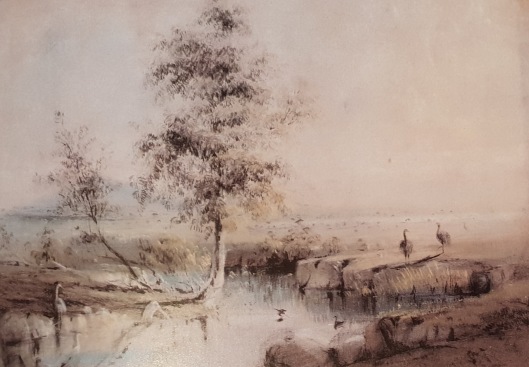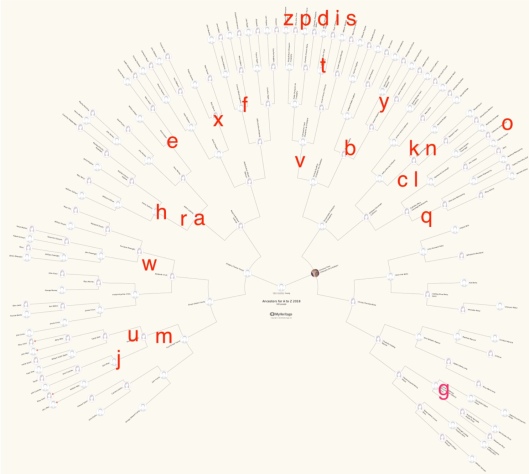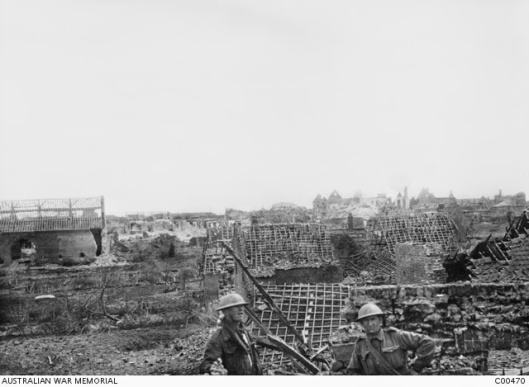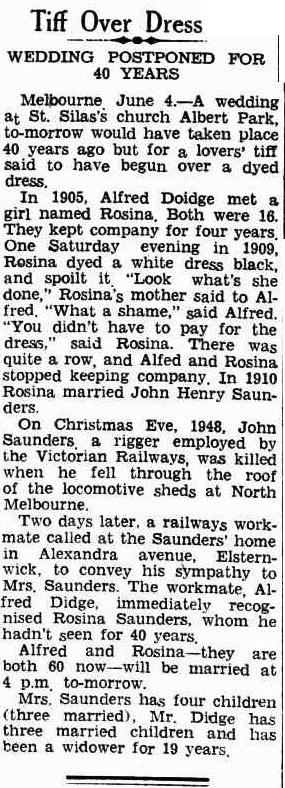One of my fourth great aunts was Theresa Susannah Eunice Snell Poole formerly Walker née Chauncy (1807-1876).

Theresa Walker in 1846 painted by her sister Martha Berkeley. Oil on metal. In the collection of the Art Gallery of South Australia.
Theresa was the oldest daughter of William Snell Chauncy née Brown (1781-1845) and Rose Theresa Chauncy née Lamothe (1748-1818).
Her brother, Philip Lamothe Snell Chauncy (1816-1880), wrote a memoir of his sister, Memoir of the late Mrs. G.H. Poole by her brother, first published in 1877. In 1976 it was reprinted, with a memoir of his wife, as Memoirs of Mrs Poole and Mrs Chauncy. Much of my information about Theresa comes from these memoirs and I quote from them below.
Her father [William Chauncy] was sent from England to be educated by his relative, the Rev. Hugh Stowell, Rector of Balaugh, in the Isle of Man, and used as a child, to play with her mother [Rose Lamothe] when she was ten years old. In after years an attachment sprang up between them, and he frequently visited the island, where they were married in 1804 – the year in which the Bible Society was founded, and in which Napoleon crowned himself Emperor of the French.
In the course of time her father and mother went to reside at Keynsham, near Bath, and on the 19th February, 1807, was born the subject of this memoir, whom they named Theresa Susannah Eunice.
I believe her mother lost one or two of her first children in early infancy, so that Theresa was the only one living at her birth. On the 18th August, 1813, Martha, now Mrs Berkeley, was born. I [Philip Chauncy] first saw the light on 21st June, 1816, and our mother died after childbirth in 1818. Our father married again in 1819, and had five children by this marriage.
In November, 1820, we went to France, where we resided, chiefly in the south, for four years and nine months. We lived at Angoulême [between Poitiers and Bordeaux] for two-and-a-half years, and while there I became ill, and well do I remember how lovingly my dear sister attended to me.
Theresa’s education was conducted chiefly at home by our father. She was but a brief period at school, for he considered it injurious to the faith and morals of his children to send them to school in France. At Angoulême, M. Labouchér was her music master, but whether for want of taste or perseverence, she never continued the practice of music. She soon became proficient in the French language, and at Mont D’Or [near Lyons] took lessons in Italian.
The memoir goes on with other incidents including hearing the Reverend Caesar Malan [Henri Abraham César Malan (1787–1864), Swiss Calvinist minister] preach at Geneva and losing Theresa’s little Italian greyhound. Theresa was sent on a visit to her grandfather at Wingfield, “where she tendered us good service by watching and partially defeating the intrigues of another branch of the family who were using every exertion to obtain an undue share of property from my grandfather in his old age. I [Philip] think Theresa must have been at Wingfield for several years”.
In the 1830s Theresa lived in London.
While in London she and Martha became members of Mr Edward Irving’s [(1792-1834), charismatic preacher and prophet] church at 13 Newman-street, Oxford-street, and there, too, they studied the fine arts under good masters – painting, drawing, and modelling; in these, especially the last, she was decidedly clever.
In 1836 Theresa and Martha, who had very recently married Captain Charles Berkley (1801-1856), emigrated in the “John Renwick“ to the new colony of South Australia, arriving in February 1837, just weeks after its proclamation.
Unfortunately there was “an incompatibility of temper and disposition between the two sisters that rendered their further residence together undesirable”, so that in 1837, Theresa left Adelaide to visit some friends in Tasmania.
On 17 May 1838 at Launceston, Tasmania, Theresa married John Walker (1796-1855), a retired naval officer. They moved to Adelaide, where Walker carried on business as a general merchant and shipping agent. The suburb of Walkerville is named after him.

John Walker painted in 1846 by his sister-in-law Martha Berkeley. The painting is now hanging in the Art Gallery of South Australia.

Kertamaroo, a Native of South Australia, modelled by Theresa Walker in about 1840. This is possibly one of the two models of Aborigines exhibited at the Royal Academy in London in 1841.

Havering about 1839 pastel on paper by Theresa Walker. Havering was a farm established by the Walkers on the banks of the upper Torrens, Adelaide.

A wax portrait by Theresa Walker in the Town of Walkerville Civic Collection is of the artist herself, made in 1840. From the Town of Walkerville Collections Policy 2014-2018 : This wax portrait of Theresa Walker is described as neo-classical in style and regarded as one of her finest works. While the association of the Walkers with the settlement of Walkerville was short lived, (as the unfortunate Captain Walker ended up bankrupt and in prison in 1841) nearly a hundred years later in May 1948, the great-nephew of Theresa Walker, Sir Trent de Crespigny, gifted these valuable and rare artworks to the Town of Walkerville. Sir Trent de Crespigny [my great grandfather] stated that these gifts were in recognition of Theresa Walker’s historical connection to the township. These works are of national significance because of their historical association with Australia’s first female colonial sculptor and because they are of great aesthetic merit and provide a rare and unique representation of the people themselves.
Philip emigrated to South Australia in 1839. When he arrived he found the Walkers were doing very well and entertaining in style. Unfortunately, in 1841 John Walker became insolvent, having “failed for a large amount”. He was imprisoned.
In 1846 John and Theresa Walker moved to near Sydney, New South Wales, and then to Tasmania where John Walker became Port officer at Hobart and later, Harbour Master at Launceston. John Walker died in 1855 aged 58.
Theresa had for some time fallen in with the religious tenets of Mr. George Herbert Poole (1806-1869), who was the founder of “The New Church” [Swedenborgian] in Adelaide. He [Poole] had returned from Mauritius, where he had been a professor in the Royal College, to Sydney in January 1850, had left Melbourne for England in 1852, and returned to Launceston in 1856, where they [George Poole and Theresa] were married.
The Pooles first had a farm in Tasmania bought, her brother notes, “with Theresa’s money”. About two years later they sold the farm and moved to Victoria where George Poole tried gold mining. In 1861 the Pooles joined a vineyard enterprise near Barnawartha on the Murray near Albury with, among others, Theresa’s half brother William Chauncy (1820-1878) who was then at Wodonga. George Poole “was supposed to be a thorough vigneron, as well as a connoisseur of the best methods of tobacco growing.” He was appointed local manager. For a number of years all went well but the scheme collapsed in 1864.
While at Barnawartha Theresa collected some of the first drawings of the Aboriginal artist Tommy McRae (1835-1901) who was also known as Tommy Barnes.

Drawing by Tommy Barnes / an aboriginal of the Upper Murray / in 1862. Given to P. Chauncy / by Mrs G.H. Poole. This drawing showing Dancers with weapons; Hunting and fishing; European house and couple has been woven into a tapestry woven in 2001 for the Centenary of Federation and now in the collection of Museum Victoria.
.

Lithograph of Ocean Perch (Helicolenus percoides) hand coloured by Theresa Poole for The Prodromus of the Zoology of Victoria. From Museum Victoria. in 1861 Theresa was commissioned to hand colour 1000 copies of this plate.

My great great grandmother Annie Chauncy (1857-1883), daughter of Philip, modelled in wax by her aunt Theresa. The cast wax model is in the collection of the National Gallery of Australia. They believe the model was made about 1860. Annie would have only been 3. I think it possible the model was made in 1864 when Theresa stayed with the family and Annie was 7.
George Poole returned to Mauritius in November 1864 and Theresa followed him in April 1865. They lived there for about four years. While in Mauritius Theresa made wax models of eighty species of fruits. These were displayed at the Paris exhibition of 1867 and she was awarded a silver medal, even though some had been damaged in transit.
In late 1866 the Pooles both became ill with fever in an epidemic. They moved to India and, after a brief return to Mauritius, in February 1868 moved back to Adelaide. George Poole gained a job as a teacher of a school at Navan near Riverton, South Australia about 100 kilometres north of Adelaide. In 1869 he became ill and died. This left Theresa almost penniless.
In 1870 she stayed for a while with William in Wodonga and then came to live with Philip and help with his children, his wife Susan having died in 1867. She lived with Philip for four years. In 1874 she visited friends in the Western District of Victoria, there taking up the position of Lady Superintendent at the Alexandra College in Hamilton. Later, ill with breast cancer, she went to Melbourne to live. In April 1875 she underwent an operation to remove her breast.
On 17 April 1876, Easter Monday, Theresa died at her house in East Melbourne. Her brother Philip was with her when she passed away.
She was buried at St Kilda cemetery. Philip arranged for her to be interred, in accordance with her wishes, in a wicker ‘mortuary cradle’ rather than the conventional coffin.
Theresa had written about mortuary cradles to the Melbourne Herald in September 1875 and apparently had ordered her own.

MORTUARY CRADLES. (1875, September 23). The Herald (Melbourne, Vic. : 1861 – 1954), p. 3. Retrieved from http://nla.gov.au/nla.news-article244179646 [Note from Greg: The reference to ‘a Mr Home’ in the “Herald” quote is an allusion to the spiritualist medium D.D. Home, who had frequently demonstrated his power to defy gravity. He could levitate at will, or so it was said, and would hover in the air to write on the ceiling. He once flew out a third-floor window, returning through the window of the next room.]

A Novel Coffin. (1875, September 20). The Herald (Melbourne), p. 3. Retrieved rom http://nla.gov.au/nla.news-article244179533 This was Theresa’s coffin as she referred to the article in her letter of 22 September. In his memoir Philip says he used the coffin for her burial.
Sir Francis Seymour Haden (1818-1910), an English surgeon and etcher, was a proponent of earth-to-earth burial. In 1875 he wrote a number of letters to The Times and held an exhibition of wicker coffins in London.
Theresa Walker is thought to be Australia’s first female sculptor. She was the first resident Australian artist to be shown in the Royal Academy of Arts in London.
Sources and further reading
- Chauncy, Philip Lamothe Snell Memoirs of Mrs. Poole and Mrs. Chauncy. Lowden, Kilmore, Vic, 1976.
- Hylton, Jane, Berkeley, Martha, 1813-1899, Walker, Theresa, 1807-1876, Art Gallery of South Australia. Board and South Australia. Women’s Suffrage Centenary Steering Committee Colonial sisters : Martha Berkeley & Theresa Walker, South Australia’s first professional artists. Art Gallery Board of South Australia, Adelaide, 1994.
- Transcribed journal of Theresa Chauncy of the first three months of her time in the Colony of South Australia digitised by the State Library of South Australia https://collections.slsa.sa.gov.au/resource/D+7604/1(L)
- INSOLVENCY COURT. (1841, August 10). Southern Australian (Adelaide, SA : 1838 – 1844), p. 3. Retrieved from http://nla.gov.au/nla.news-article71615117 also related articles:
-
- INSOLVENT DEBTORS’ COURT. (1841, August 24). Southern Australian (Adelaide, SA : 1838 – 1844), p. 3. Retrieved from http://nla.gov.au/nla.news-article71615200
- Advertising (1845, September 6). Adelaide Observer (SA : 1843 – 1904), p. 4. Retrieved from http://nla.gov.au/nla.news-article158920785
- Correspondence. (1845, July 1). South Australian (Adelaide, SA : 1844 – 1851), p. 2. Retrieved from http://nla.gov.au/nla.news-article71601992
- THE HAVERING PROPERTY, THE LAWYERS, AND THE SUPREME COURT. (1845, July 29). South Australian, p. 3. Retrieved from http://nla.gov.au/nla.news-article71602239
- Roughley, Julianne, et al. “Design and Art Australia Online.” Theresa Walker :: Biography at :: at Design and Art Australia Online, Design & Art Australia Online, 1995, www.daao.org.au/bio/theresa-walker/biography/.
- National Portrait Gallery: Theresa Walker
- The Town of Walkerville Collections Policy 2014-2018
Related posts










































